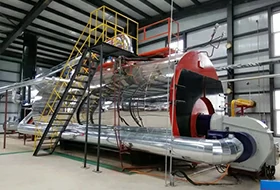
Feb . 19, 2025 06:54 Back to list
oil fired hot water boiler
Draining a hot water boiler system is a crucial maintenance task that can enhance the efficiency and longevity of your heating system. As an expert versed in maintaining heating systems, I will guide you through the process, emphasizing the importance of this simple yet necessary procedure.
While the system drains, take the opportunity to inspect the water for rust or excessive dirt. The presence of these materials may indicate internal corrosion or other issues, necessitating a professional inspection and possible maintenance. After the water has completely drained, close the drain valve and radiator air vents to prepare for refilling. Refill the boiler system by opening the water supply valve, ensuring it fills gradually to prevent airlocks in the system. This slow filling also allows you to inspect for leaks at the connections, which should be addressed immediately to maintain system integrity. Perform a final inspection of your system. Check for any leaks or unusual noises when you restart the boiler to ensure everything is functioning correctly. The restart should be gradual, monitoring pressure gauges to ensure safe operation. Regular draining of a hot water boiler system, done once or twice a year depending on usage, can prevent potential problems and extend the life of the system. While this guide provides a comprehensive approach for homeowners, always consider consulting with a heating professional for extensive repairs or if uncertain about any step. By understanding and performing these maintenance tasks, you contribute to the efficient operation of your home's heating system, optimize energy consumption, and ensure a warm, comfortable environment during those colder months. Adhering to these professional insights not only elevates the safety and functionality of your boiler but also aligns with best practices for household maintenance excellence. For homeowners and industry professionals alike, maintaining a hot water boiler system is paramount. Implementing these steps confirms a commitment to home care, adding to your property's value while shielding against unforeseen heating issues.


While the system drains, take the opportunity to inspect the water for rust or excessive dirt. The presence of these materials may indicate internal corrosion or other issues, necessitating a professional inspection and possible maintenance. After the water has completely drained, close the drain valve and radiator air vents to prepare for refilling. Refill the boiler system by opening the water supply valve, ensuring it fills gradually to prevent airlocks in the system. This slow filling also allows you to inspect for leaks at the connections, which should be addressed immediately to maintain system integrity. Perform a final inspection of your system. Check for any leaks or unusual noises when you restart the boiler to ensure everything is functioning correctly. The restart should be gradual, monitoring pressure gauges to ensure safe operation. Regular draining of a hot water boiler system, done once or twice a year depending on usage, can prevent potential problems and extend the life of the system. While this guide provides a comprehensive approach for homeowners, always consider consulting with a heating professional for extensive repairs or if uncertain about any step. By understanding and performing these maintenance tasks, you contribute to the efficient operation of your home's heating system, optimize energy consumption, and ensure a warm, comfortable environment during those colder months. Adhering to these professional insights not only elevates the safety and functionality of your boiler but also aligns with best practices for household maintenance excellence. For homeowners and industry professionals alike, maintaining a hot water boiler system is paramount. Implementing these steps confirms a commitment to home care, adding to your property's value while shielding against unforeseen heating issues.
Share
Latest News
-
Oil Fired Hot Water Boilers Sale - High Efficiency & Affordable
NewsJul.31,2025
-
High-Efficiency Commercial Oil Fired Steam Boiler for Industry
NewsJul.30,2025
-
High-Efficiency Biomass Fired Thermal Oil Boiler Solutions
NewsJul.30,2025
-
High Efficiency Gas Fired Thermal Oil Boiler for Industrial Heating
NewsJul.29,2025
-
High-Efficiency Gas Fired Hot Water Boiler for Sale – Reliable & Affordable
NewsJul.29,2025
-
High Efficiency Biomass Fired Hot Water Boiler for Industrial and Commercial Use
NewsJul.29,2025
Related PRODUCTS
Copyright © 2025 HEBEI HONGZE BOILER MANUFACTURING CO., LTD. All Rights Reserved. Sitemap | Privacy Policy






















